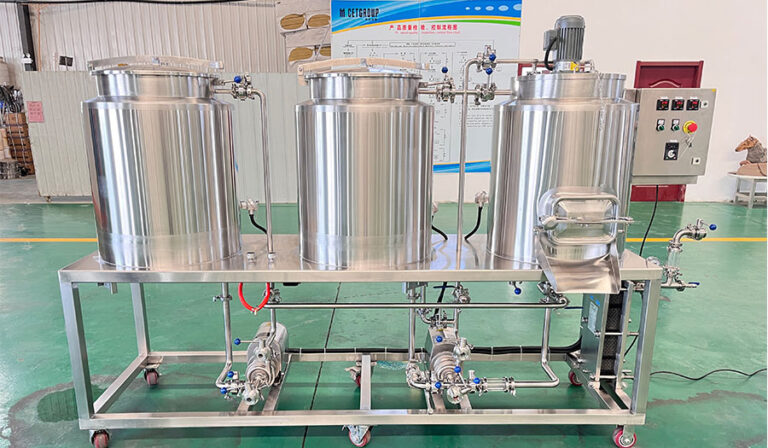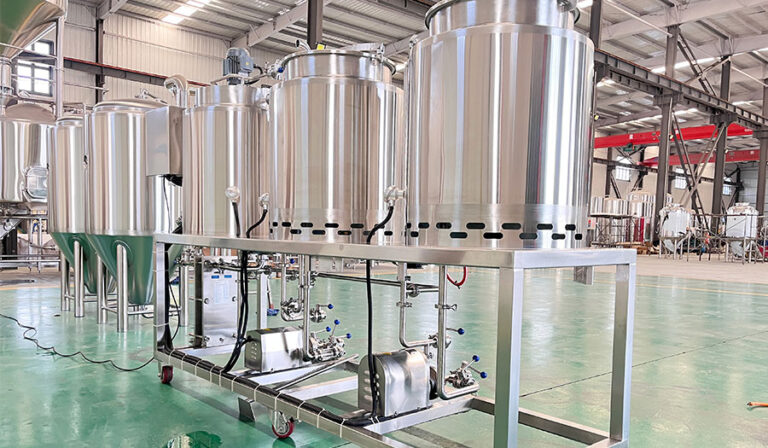A brewery brewing system is an integrated device that simplifies the beer brewing process for home and small breweries. It integrates the multiple steps of traditional beer brewing (such as mash, boiling, cooling, and fermentation) into a highly efficient and easy-to-operate process through a highly automated design. This guide introduces the beer brewing system, which allows users to enjoy the fun of brewing beer at home easily. As brewers’ enthusiasm for home brewing continues to rise, the emergence of all-in-one brewing systems provides efficient, convenient, and creative solutions, allowing everyone to become their own “brewing master”.

All-in-one brewing is a process that integrates multiple steps of the beer brewing process into one system or device. This system reduces the complexity of traditional beer brewing and enables consumers to produce a variety of beer flavors more conveniently at home or in small breweries. Specifically, beer-All-in-one brewing systems usually include the following key features:
- Automated control: The All-in-one brewing system usually includes intelligent control functions, which can automatically adjust parameters such as temperature and soaking time, thereby reducing manual intervention and improving the consistency and efficiency of papermaking.
- Integrated design: Traditional beer brewing requires more equipment, such as mash tanks, boiling pots, pickling tanks, etc. The All-in-one brewing equipment integrates these functions into one machine, reducing the space occupied by the equipment and the operation introduction. 3
- Versatility: Many standardized brewing systems can be used to create different beer flavors. Users can adjust the recipe according to their taste requirements and even brew other types of drinks.
- User-friendly: Suitable for both novice and experienced brewers. The user interface and simplified operation steps are provided, making it easy for even beginners to get started.
- Easy to clean: An All-in-one brewing system is usually used. To be cleaner, the cleaning expenses caused by the complexity of the equipment structure are reduced, ensuring that subsequent maintenance is more convenient.
Through these features, the integrated beer brewing system not only provides a convenient operating experience but also allows users to better explore and enjoy the fun of brewing.
Important components of the All-in-one brewing system
An efficient equipment in beer brewing that integrates multiple functions into one system to simplify and optimize the brewing process. Here are some important components:
- Mash Tun: used to mix malt with water for the mashprocess to extract sugars. Usually has a temperature control function to ensure that the mash process is carried out at the right temperature.
- Boiling pot: Here the wort is boiled and hops are added to increase the bitterness and aroma of the beer. The boiling process also helps sterilize.
- Cooler: Used to quickly cool the boiled wort to the fermentation temperature to prevent bacterial growth. This is usually an efficient heat exchange system.
- Tanque de fermentação: Yeast is added here for fermentation. Fermentation tanks usually have temperature control functions to provide a stable fermentation environment.
- Depósito de armazenamento: Used to further mature and carbonate beer after fermentation, which helps improve taste and flavor.
- Control system: Integrated monitoring and control equipment that can adjust and monitor parameters such as temperature, pressure, degree of automation, etc. of each process in real-time.
- Cleaning system: used for cleaning and maintenance of equipment, ensuring the hygiene of the entire system, preventing cross-contamination, and ensuring the quality of beer.
- Packaging system: facilitates the filling, bottling, or canning of finished beer, usually including labeling and automated packaging equipment.
- Raw material storage and delivery system: used to store and automatically deliver required raw materials, such as malt, hops, and additives, to ensure accurate delivery.
The All-in-one brewing system can improve brewing efficiency, and save space and human resources while maintaining the flavor and quality of beer by integrating these components. It is an indispensable piece of equipment in modern beer production.
All-in-one brewing System Features
The craft and science of brewing involve multiple stages, each of which is critical to the quality and flavor of the final product. Professional brewing systems integrate these stages, ensuring efficiency, consistency, and scalability.
- Mashing: This initial step involves soaking the grains in hot water to activate enzymes that convert starches into fermentable sugars. The brewing system’s mash tun facilitates this process.
- Boiling: The sweet liquid obtained after mashing, called wort, is boiled in a boiling kettle along with hops. This stage not only extracts flavor from the hops but also sterilizes the wort.
- Cooling: After boiling, it is critical to quickly cool the wort to a temperature that is conducive to fermentation. Modern brewing systems are equipped with efficient heat exchangers to speed up the cooling process.
- Fermentation: The cooled wort is transferred to a fermentation tank and yeast is added. The yeast consumes the fermentable sugars, producing alcohol and carbon dioxide in the process. Depending on the type of beer, fermentation can last from a few days to a few weeks.
- Maturation: Once fermentation is complete, the beer is ready to mature. This period allows flavor to develop and consumes any residual sugars. Some beers may require a longer maturation period, while others can be drunk relatively fresh.
Advantages of an All-in-One Brewing System
- Consistency: One of the significant challenges facing brewers is maintaining consistency between beer batches. Professional brewing systems precisely control every stage, from mashing temperature to fermentation time, ensuring that each batch of beer has the same flavor and quality as the last.
- Efficiency: Time is of the essence in brewing, especially in a commercial setting. These systems streamline the brewing process, shorten the time between batches, and optimize the use of ingredients. This efficiency not only speeds up production but also saves costs in the long run.
- Scalability: As a brewery’s reputation and demand grow, scaling up production becomes a necessity. Professional brewing systems are designed with this growth in mind. Modular systems allow breweries to expand capacity without completely overhauling the entire facility.
- Quality Control: With advanced sensors and digital monitoring tools, modern brewing systems provide real-time feedback. This instant data access enables brewers to make on-the-spot adjustments, ensuring that the final product meets the desired quality parameters.
- Flexibility: The dynamic nature of the beer industry requires beer versatility. Brewers often adjust recipes or try new ingredients. Professional systems have the flexibility to make these changes seamlessly, allowing brewers to innovate without restrictions.
- Safety: Brewing, while satisfying, is potentially dangerous, from handling boiling liquids to managing pressurized fermentation tanks. Professional systems are equipped with safety mechanisms to protect brewers from accidents, making the brewing process safer and more reliable.

How to choose an All-in-one brewing system?
- Production scale: Choose the right system size and processing capacity based on your own production needs, whether it is small home brewing or large commercial brewing.
- Budget: Set a clear budget range and choose a system that meets functional requirements within an acceptable price.
- Required functions: Identify the required functions, such as heating, cooling, fermentation, cleaning, etc., including whether additional automation options are required.
- Energy efficiency: Consider the energy consumption and efficiency of the system to reduce operating costs and support sustainable development.
- Space constraints: Evaluate the available space and ensure that the size of the selected equipment can accommodate the current facility layout.
- After-sales service and support: Choose a manufacturer that provides good after-sales service to ensure that there is technical support and maintenance guarantee.
- User experience: Understand the system’s operator-friendliness and training support to ensure that operators can get started quickly and easily.
- Customization options: Ask the manufacturer whether it provides customization services to adjust according to specific needs.
FAQ
What is an All-in-one brewing system?
An All-in-one brewing system is a device that combines multiple brewing process functions, usually including raw material feeding, heating, cooling, fermentation, and cleaning processes, aiming to improve production efficiency and product quality.
What scale of production is the All-in-one brewing system suitable for?
The All-in-one brewing system can be flexibly adjusted and expanded according to needs and is suitable for small home breweries as well as large commercial breweries.
Is the All-in-one brewing system easy to operate?
Modern All-in-one brewing systems are usually equipped with user-friendly interfaces and advanced monitoring technology, making operations simple and intuitive. In addition, the degree of automation of the system also reduces the complexity of operation.




